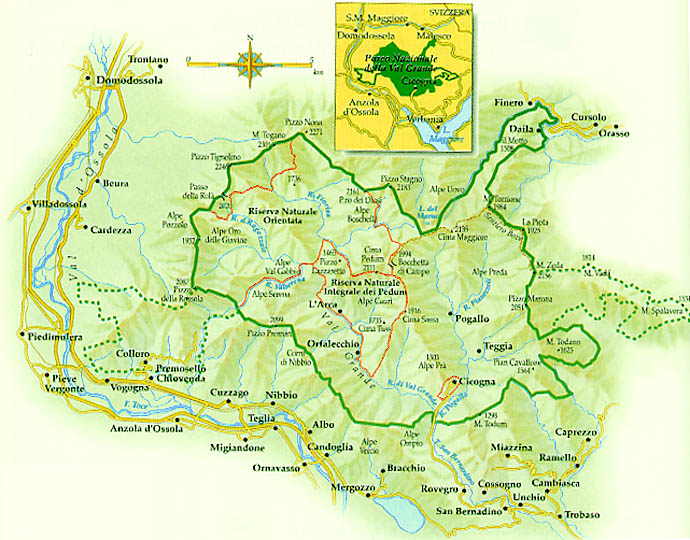|
Hiking the wild Val Grande (Adapted and translated from an article by Werner
Spirig in nzz-online, May 2002)
Intragna lies in the midst of a birch and chestnut forest which covers the mountainous
back country of Lake Maggiore like a soft, deep green carpet. The nearby Val Grande, located between the lake, the Ossola
Valley, the Valle de Vigezza, and the Centovalli in the southwestern corner of the Ticino, is the largest nature preserve
in Italy. Since 1969, when the hamlet of Serena was abandoned, the confines of the preserve have "returned" to their
natural wild state, with no farming or shepherding activity.

The goal of our `day one' hiking trip is the Monte Zeda, at 2156 meters the tallest and best known peak in the park.
The Italian Alpine Club's hut, the Refugio Pian Cavallone, an hour and a half from Intragna, is a perfect
starting point. It is the only "full service" mountain hut in the park; our four-bed room is simply furnished
and the shower water is heated by a wood-burning stove.
Refreshed, we begin our two-hour hike up the Monte Marone
with an easy walk along the grassy Colle de la Forcolla. The trekking becomes more challenging as we skirt cliff walls,
negotiating the terrian with the help of handrails and chains, until we reach the top and enjoy the view of Lake Maggiore.
Then, another hour and a half hike to the top of Monte Zeda, where we are dazzled by the panorama of cobalt blue
lakes (Maggiore, Varese, Orta) to the south and east and by the towering Cima Pedum massif to the north and west in the heart
of the Val Grande nature preserve.
The Val Grande has a multitude of hiking trails. As our starting point the
following day, we've chosen Colloro above Premosello, which we drive to on a good road. From there we walk for three
hours to the Alpe Colma, a saddle of land between the Pizzo Proman and the Pizzo della Rossola. It begins to rain heavily,
a not uncommon occurrence in the Val Grande. We take cover in a roomy stone building, equipped with a long table, benches,
and a wood stove.
After a brief rest, we set of in the driving rain and climb down a zig zag trail into the Val Gabbio.
Far below, a mountain stream crashes along; we have the impression that we're coming closer to it, but never quite
close enough to see. The trail passes through the Alpe Serena. The stone houses, long abandoned, are falling down,
but they evoke a sense of centuries of Alpine agriculture. In his book, Val Grande, Paolo Crosa Lenz interviewed
a farmer who remembered how, shortly before World War II, around a hundred families lived in Premosello and summered in the
Val Grande mountains with their 260 cattle and 1600 goats.
The walk down from the Alpe Colma, including an unplanned
detour when we missed a trail marking, takes about four hours. We'll spend the evening in a stone building in the Val
Gabbio; a young Italian couple has already prepared a fire. Outside, nightfall shrouds this quiet place which
emanates an air of mystery.
The next morning, the weather having cleared, we can see clearly how narrow the
valley is, surrounded by what was once a primeval beech forest. The six-hour walk out of the wilderness is not the least
monotonous, and includes passage over a suspension bridge, a gradual ascent to the Alpe Scaredi, a view of the cliff wall
of Pedum, and finally an inviting natural pool, perfect for a refreshing dip.
|